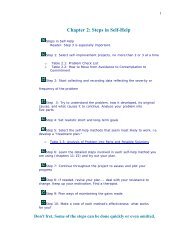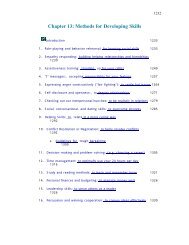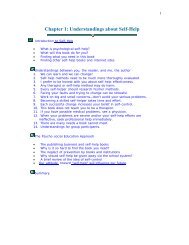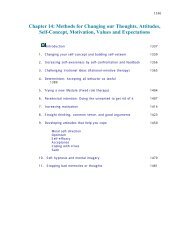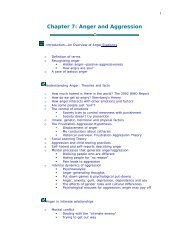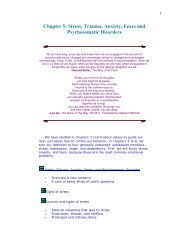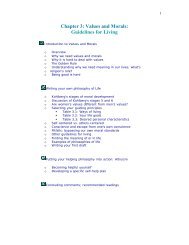Methods for Changing Behaviors - Psychological Self-Help
Methods for Changing Behaviors - Psychological Self-Help
Methods for Changing Behaviors - Psychological Self-Help
You also want an ePaper? Increase the reach of your titles
YUMPU automatically turns print PDFs into web optimized ePapers that Google loves.
STEP THREE: Make up a contract <strong>for</strong> the administration of the<br />
punishment.<br />
Be very precise about when the punishment will be given, what it<br />
is, and what it is <strong>for</strong>. See method #16 <strong>for</strong> an example of a contract.<br />
Don't cop out.<br />
There are two basic methods of aversive conditioning: "punishment<br />
training" and "classical conditioning." Example of punishment training:<br />
Over 35 years ago 5000 alcoholics were given drugs to induce nausea<br />
and vomiting after drinking alcohol. They had a 50% success rate after<br />
6-10 hours of treatment; that's remarkable. Examples of classical<br />
conditioning: pairing electric shock with the sight and smell of a glass<br />
of whisky or shocking a homosexual while he/she is fantasizing some<br />
homosexual experience.<br />
The learning principles in punishment training are about the same<br />
as learning desired traits by positive rein<strong>for</strong>cement: administer the<br />
punishment immediately following the unwanted behavior, administer<br />
it full strength and 100% of the time at first (but not so often one gets<br />
"used to it"), and provide support <strong>for</strong> desired behaviors to replace the<br />
unwanted behaviors.<br />
In addition to punishing the unwanted behavior, it may be helpful<br />
to "punish" (pair with something unpleasant) the stimuli and cues that<br />
precede (in the behavior chain) or initiate the unwanted behavior as<br />
well. Example: flip your wrist with a rubber band when you do<br />
anything associated with smoking, e.g. buy a pack of cigarettes, open<br />
the pack, feel the urge to smoke, see an ash tray, feel tense, want a<br />
beer, etc.<br />
STEP FOUR: Try the punishment and see the results; encourage<br />
the desired behavior.<br />
In most cases there are behaviors that should be substituted <strong>for</strong><br />
the unwanted behavior. They should be learned and practiced and<br />
rein<strong>for</strong>ced be<strong>for</strong>e the old behavior is punished. Often the avoidance of<br />
punishment is the negative rein<strong>for</strong>cement <strong>for</strong> the desired behavior<br />
(see method #17).<br />
Time involved<br />
Total time involved=1 to 2 hours. It may take a few minutes each<br />
day to carry out the punishment. But the entire procedure is usually<br />
quick, 1 to 3 weeks, if the punishment is effective.<br />
Common problems with the method<br />
Quitting or just "<strong>for</strong>getting" is common. Don't <strong>for</strong>get, the pain from<br />
self-punishment is punishing your self-help ef<strong>for</strong>ts to change just as<br />
much as it is punishing the unwanted behavior. Also, <strong>for</strong> unknown<br />
1144



